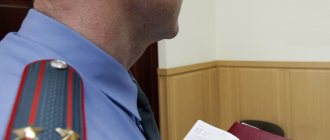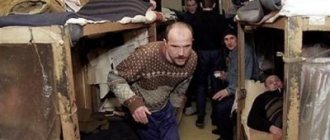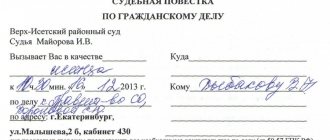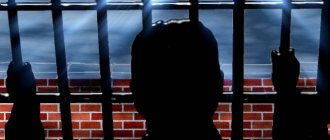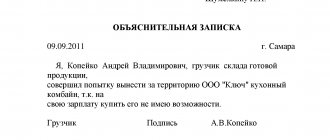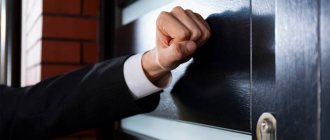How to behave in a confrontation
Confrontation - what you need to be prepared for, what you need to know about confrontation, how it happens. All of the above questions will be explained to the suspect or accused by a lawyer, the testimony and actions, and the investigator’s questions during the confrontation are discussed with the lawyer.
But, if you are a person involved in a criminal case - a witness or a victim, you will not be provided with an appointed lawyer by law; you must either rely on your own strength or turn to a paid lawyer. To understand relatively superficially what an investigative action such as a confrontation is, read this article.
Confrontation is an investigative action regulated by Art. 192 of the Code of Criminal Procedure of the Russian Federation, the purpose of which, according to the first part of this article, is to eliminate contradictions in the testimony of interrogated persons. In reality, in many cases, confrontations do not eliminate any contradictions; the participants in such an investigative action confirm their testimony and disagree, and contradictions remain. Since in many criminal cases most of the evidence does not clearly confirm the guilt of the person brought to justice and is of a formal nature, the confrontation is another similar piece of evidence and is carried out not out of real necessity on the initiative of the investigator, but at the direction of higher-ups or a supervisory authority in the name of the prosecutor's office. But, there are also “real” confrontations, during which it is necessary to what is called “hold the line.”
What you need to be prepared for in a confrontation
You need to clearly understand that during a real confrontation you will be faced with a person with his lawyer who holds a position different from yours. Therefore, the best solution would be to contact a lawyer and prepare with him for a confrontation. At the very least, you should prepare for a confrontation yourself. It is necessary to remember your testimony and consolidate it in your memory to the smallest detail, think through the questions that may arise regarding contradictions, and prepare answers to these questions. In addition, you need to prepare psychologically for a confrontation, you need to get a good night's sleep, control your self-control, and remember that the other side is no less concerned about the same issues than you.
How to behave in a confrontation
During the confrontation itself, you should confidently confirm the previously given testimony and listen to the testimony of the other side. At the same time, the investigator in whose proceedings the case is located may ask questions and ask for answers regarding the testimony of the other party. But the most unexpected may come from the opposing lawyer. This is where provocative questions may come from, and attempts may be made to throw you off balance. Don't lose your composure, stay calm, and think through your answers to questions carefully. If there are any incomprehensible insinuations, ask for such actions to be included in the protocol. You should be prepared for pressure both from the investigator and from the other interrogated party participating in the confrontation. It is necessary not to succumb to provocations, and not to “float” in the testimony.
If during the confrontation your rights were violated, there was pressure or provocation, such facts should be entered into the protocol. Also, violations of the law during a confrontation can be appealed in accordance with Art. 125 Code of Criminal Procedure of the Russian Federation.
In order to prevent your positions from being pushed through in a confrontation, you need to carefully prepare for it and appear at the confrontation with a lawyer; the very fact of a lawyer’s presence will clear up many questions. If it is not possible to use the services of a lawyer, then do not neglect the consultation of a professional criminal lawyer. To get help from a lawyer in a confrontation, call the phone number listed on the website.
Request for a confrontation
As a rule, the official conducting the preliminary investigation or inquiry independently decides on the advisability of conducting a confrontation. However, any participant in a criminal case can apply for a confrontation.
Such a petition can be verbally stated to the official during the interrogation and must be entered into the protocol, or the person independently records it in the “additions”, “notes” or “petitions” column of the protocol.
Also, such a petition may be submitted to the official in writing. Please note that for consideration of the application by an official, in accordance with Art. 121 of the Criminal Procedure Code of the Russian Federation, there is no more than 3 days.
What should a suspect do?
For a suspect, a confrontation is a real test, a kind of psychological battle with the participants in the process. Such interrogation can have two consequences for him. On the one hand, for example, having exposed an unscrupulous witness, he gets the opportunity to prove his innocence. This will be the first step towards his acquittal. On the other hand, circumstances may work in favor of the prosecution. Then punishment will be inevitable.
To exclude the second option, you need to clearly understand how to behave in a confrontation with a suspect:
- You need to speak confidently so that every phrase spoken does not raise doubts. It is better to stand your ground if the other side has no valid arguments.
- You need to admit only what is impossible to deny at the moment.
- Sometimes it is worth trying to play by the rules of the investigator: if he is aggressive, then it is better to feign fear, and in a heart-to-heart conversation, try to feign understanding. This will partly help win him over to your side.
- Refuse threats and any negativity. Such actions can only anger law enforcement officials.
- The presence of a lawyer will help avoid unnecessary mistakes.
- If necessary, you can submit various petitions, demanding that they be entered into the protocol.
Sequence
The sequence is determined by an authorized person (investigator).
The order of questions is established. The sequence depends on the specific case. Practice shows that the investigator first asks questions to those who, from his point of view, give truthful answers. This sequence is observed in cases where the interrogated person changes his testimony under the influence of a second opponent. In cases where contradictions are clarified in several circumstances, each person is invited to present his version first of one fact, then vice versa. A situation is possible when, with the permission of the person conducting the investigation, the parties ask questions to each other. The investigator actively participates in the work: records testimony, rejects questions both completely and partially. The event helps to expose liars. They are often confused in their answers. There are frequent cases of attempts by opponents to influence each other:
- Threats.
- By intimidation.
- Trying to come to an agreement.
- Other actions.
Then the investigation must be interrupted, this fact must be reflected in writing. The legislation requires the testimony to be made public first, limiting the influence of the investigator on those involved, and one party on the other. If the opponent refused to testify in a confrontation, then the previous testimony cannot be read out. Investigators ignore this rule. The violation must be recorded and an entry is made in the document.
Practice proves that psychological influence plays a huge role. There are many ways to force a liar to tell the truth. Investigators use the effect of surprise. They do not tell participants the date of the future meeting.
The results are then analyzed. If there are no results, other means are sought. In anticipation of the upcoming trial, the search for new evidence continues.
An example from practice: a criminal case was being investigated, opponents told different versions of what happened. The investigator used the effect of surprise and called the participants to testify. The results of the investigative action did not bring the desired result. The accused was activated in search of new evidence of the absence of a crime event. Evidence was found and presented at the trial. Fixing materials
The investigator records the information of the participants about the crime committed and draws up a protocol of the confrontation. After examining several events, the readings are recorded one by one. First the first event, then the second.
In practice, there are two ways to prepare a document:
- Linear entry of information. First the question, then the answer.
- The sheet is visually divided into two parts vertically. The testimony of the first opponent is recorded on one half, and the testimony of the second on the other half.
This formatting of documents facilitates quick retrieval of information and analysis of information.
Documents are drawn up in handwritten and printed form. Testimony is presented in the first person, wording and expressions are recorded verbatim. The meaning of the story cannot be distorted; sometimes investigators deliberately change it. This action is illegal. First you need to record the violation, and then write a remark at the end of the document. The investigator introduces the protocol to the opponents, and the lawyer at the end of the procedure.
The legislation provides for the possibility of using technical means of video recording:
- the use of video recording means reveals the dishonesty of the participant’s behavior;
- With the help of video recordings, all the nuances of the participants’ behavior are visible.
The recorded video information will serve as evidence of the opponent’s dishonesty.
Legislation allows investigative authorities to ensure the safety of the victim and relatives during the investigation of particularly serious crimes. The head of the investigative body, the head of the inquiry body makes a decision. Then a pseudonym of the participant is created with a sample signature. The personal data of the citizen is attached by the investigator to the materials in a sealed envelope. The accused, suspect, and witnesses do not have access to information.
Essence of the procedure
Determining the truth is often very difficult. There are cases when two participants in a trial give completely different testimony regarding the same issue. This can happen for various reasons:
- Because of the outright delusion of one of them.
- In case of deliberate distortion of real facts. Moreover, there is a possibility that both interrogated people incorrectly describe the picture of what is happening.
It is in such cases that confrontation is used. Here, the investigator has the opportunity to ask the participants the same questions and, having discovered in their answers a contradiction or discrepancy with the testimony given earlier, try to find out its reason.
All those present must be warned in advance about such a procedure in order to decide how to behave in a confrontation. Some may want to change their testimony. Although in such a situation it is undesirable to do this. It is better to refuse to give any evidence at all than to make up something on the fly.
What is interrogation and what are the rules for conducting it?
It is important to know: a witness cannot refuse to testify (clause 2 of part 6 of article 56 of the Code of Criminal Procedure). But the suspect and the accused can (suspect: clause 2 of part 4 of article 46 of the Code of Criminal Procedure; accused: clause 3 of part 4 of article 47 of the Code of Criminal Procedure of the Russian Federation).
In the Criminal Procedure Code, articles 187 to 190 are devoted to interrogation. However, there are references to it in other articles - in total, the word “interrogation” appears 141 times in the Criminal Procedure Code.
A few facts about interrogation that you need to know if you are summoned to it:
- the witness is summoned for questioning by summons, and not by telephone call (part 1 of Article 188 of the Code of Criminal Procedure);
- interrogation at night is not allowed, except in urgent cases (part 3 of article 164 of the Code of Criminal Procedure);
- the investigator cannot ask leading questions (Part 2 of Article 189 of the Code of Criminal Procedure);
- During interrogation, photographs and video recordings may be taken, both at the initiative of the investigator and at the request of the interrogated person (Part 4 of Article 189 of the Code of Criminal Procedure);
- the interrogated person can use documents and records (part 3 of article 189 of the Code of Criminal Procedure);
- the suspect and the accused can use the services of lawyers;
- The interrogation cannot be carried out for more than 8 hours a day, and after the first 4 hours there must be a break (parts 2 and 3 of Article 187 of the Code of Criminal Procedure).
Forensics
Who needs this kind of work? Young people who earn reputation and experience in this way, who do not yet have it. Let us repeat: among public defenders there are those who sincerely strive to get their client out.
- free legal advice on interrogations and confrontations;
- presence at interrogations and confrontations;
- carrying out on your behalf procedural actions related to violations during interrogations and confrontations.
It happens that a person goes for interrogations for weeks, and then suddenly one day he becomes a suspect, or even an accused.
Strict order
Simultaneous interrogation of several persons sometimes becomes the only opportunity for the investigator to find out the truth. To achieve the desired result, he needs to follow certain tactics when conducting a confrontation. Otherwise, the procedure may be completely useless. At the same time, each of its participants must understand how to behave in a confrontation and clearly follow this position. Such a conversation usually begins with clarifying the fact that the persons being interrogated know each other and defining their relationship. These people may be friends, relatives or co-workers. In addition, it is very important to find out if there is any enmity between them. Such information is critical to assessing their evidence. Next, the investigator must ask the participants questions regarding a specific circumstance, and, after listening to the answer of each of them, enter the information received into the protocol. In this case, if any discrepancies are detected, it becomes possible to immediately clarify all the nuances and find out the cause of the discrepancy. Only after this should we move on to the next circumstance.
Tips for a lawyer
Any participant in legal proceedings may invite his or her lawyer during a confrontation. This will allow him to feel more confident during such a procedure. The role of the defense attorney will be to uphold the rule of law as much as possible in relation to his client. How should a lawyer behave in a confrontation?
Experienced defense attorneys can give some useful advice on this matter:
- First, you need to remember that the investigator in such a situation is not a friend to the lawyer. They have completely opposite goals. The investigator needs to find out as much as possible. The goal of the defense attorney is to provide the minimum amount of information necessary.
- During a confrontation, it is necessary to ensure that the client’s interests are not infringed. It is necessary to give him timely advice regarding the competence of certain issues.
- Carefully read all the documents that appear during the procedure. Perhaps there is a catch in some of these papers.
- Prevent any negative impact on the client. In an emergency, you can simply stop the conversation. At the same time, the lawyer himself must remain calm and restrain his emotions.
- Submit motions on behalf of your client that will help turn the situation in his favor.
The correct actions of a lawyer can provide the client with all possible assistance without prejudice to his interests.
Sources: https://xn—-7sbabhjc3ccc5aggbzfmfi.xn--p1ai/publications/ugolovnoe-pravo/kak-vesti-na-ochnoi-stavke/ https://businessman.ru/kak-vesti-sebya-na-ochnoy- stavke-sovetyi-yurista.html
Witness participation
Proof of a suspect's guilt is often supported by the testimony of witnesses to the incident. But sometimes they describe the same situation differently. The investigator's task is to find out the truth by determining which of the participants in the process is mistaken or deliberately misleading everyone.
The witness may attend such a conversation together with his lawyer. This is not prohibited by law. When representing the interests of his client, he must explain in advance how to behave in a confrontation with a witness:
By following these rules, the witness can count on a favorable outcome of the confrontation.

